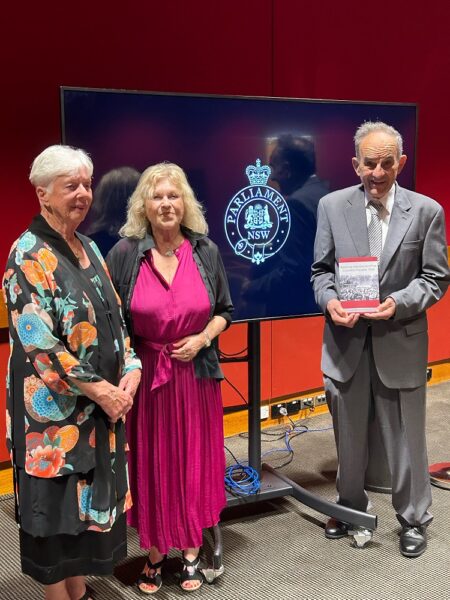
In the author’s words said on 11 October 2023 in The Parliament of New South Wales premises in Sydney, at the book’s launch, it took the best part of ten years to write this book titled “Bleiburg: Massacre of the Croatian People 1945” published by ATF Theology, Adelaide, Australia, 2023. But then, everything it seems points to the conclusion that the author, Father Zvonimir Gavranovic, a Catholic priest of Croatian roots ordained in 1972 and since then serving in various parishes in Sydney, doesn’t do things superficially or “by halves”. He is a thorough, caring, dedicated author who contemplates beyond the times his book is written and published in. It reportedly took him almost 20 years to research for and write his previous sell-out book “In search of Cardinal Stepinac: a complete biography” published 2014 by Kršćanska Sadašnjost, Zagreb Croatia. (As a reminder to readers of this article, in May 1943, Archbishop of Zagreb Alojzije Stepinac openly criticised the Nazis and put his own life in danger to save Jews and other ethnic groups facing peril. At the end of World War Two, on basis of false accusations drummed up by communist Yugoslavia authorities Stepinac was found guilty of Nazi collaboration at a mock trial, by the communist government and was convicted and sentenced sixteen years` hard labour on October 11, 1946. He spent five years in the prison of Lepoglava, and in 1951, Josip Broz Tito`s communist government released him and confined him to his birth village of Krasic in Croatia. Even though he was forbidden by the government to resume his duties as Archbishop or priest for that matter, Stepinac was named Cardinal by Pope Pius XII on January 12, 1953. Due to pain caused by the many illnesses he contracted while imprisoned, Cardinal Stepinac died in Krasic on February 10, 1960. In 1985, his trial prosecutor, high-level communist operator, Jakov Blazevic, admitted publicly that Cardinal Stepinac`s trial was entirely framed, and that Stepinac was tried only because he refused to sever thousand-year-old ties between Croatians and the Roman Catholic Church. On October 3, 1998, in Marija Bistrica, Croatia, Pope John Paul II beatified Cardinal Stepinac, and referred to him as one of the outstanding figures of the Catholic Church. In 2016, a Zagreb court overturned the verdict against Stepinac from 1946. The Canonisation process for Cardinal Alojzije Stepinac is still ongoing in the Vatican.)
Bleiburg: Massacre of Croatian People 1945
“The purpose of this book is to serve as a memorial: it speaks on behalf of all those who had their voices silenced by terror…” writes Zvonimir Gavranovic in the Introduction to his book.
Contrary to what the book’s title may suggest, this book does not wholly focus on 1945 and the events often referred to in historical studies as “The Bleiburg Massacres and Way of the Cross/ Death Marches of Croatian People” but in an ordered presentation lined with historical and historiographical accounts tells the entire history of Croatia, summarising its beginnings – traces within the ancient Roman Empire, the seventh century AD increased emergence of the establishment of Croatian peoples’ settlements, the glory of the Kingdom of Croatia (925 – 1102), centuries under Habsburg including Austro-Hungarian Empires foreign rule, the forced inclusion of Croatia into kingdoms (on the territory of former Yugoslavia) under the thumb of the Serbian Monarchy immediately after the First World War, the start of World War Two where communists fighting for retention of Yugoslavia fought against the Croatian independence movement and army right up to 1945. In all that history in this book the reader is briefly but strongly presented with individual Croatian leaders who throughout centuries of foreign rule and oppression fought for Croatian identity and independence; at times tragically losing their own life in the process and never, due to stronger opposing forces at play, successful to the end.
“Reading Chapter One of Croatian history between the seventh century and the beginning of the First World War the reader will come to realise that the Croatian and Serbian people had the best of relations for centuries. Problems started to develop after the two nations came to live together in what eventually became Yugoslavia. The biggest upheaval for the Croatian people as for all the Balkan nations was the Turkish invasions. The Turkish invasions greatly depleted the Croatian nation …” said Zvonimir Gavranovic at the Sydney launch of his book.
The Second Chapter the book deals with the creation of what later became the former Yugoslavia (ceased to exist in early 1990’s) after the First World War. In the first instance it was called the Kingdom of Serbs, Croats, and Slovenes under Serbian Monarchy and after the assassination of Croatian leadership in the parliament in Belgrade the chapter shows how tensions between Serbs and Croats grew much stronger and dictatorship from the Serb Monarchy continued ruthlessly, antagonism heightened as Serbian King in 1929 changed the name of the country to Kingdom of Yugoslavia. In this chapter the reader is introduced to how, amidst dictatorship, oppression, denial of human rights to Croats, political instability within the Kingdom of Yugoslavia – amidst the enormous political tensions withing Europe as a whole, during late 1920’s and the 1930’s, the Croatian Ustasha movement was formed (the movement that would in April of 1941 proclaim the Independent State of Croatia).
“It was in Britain’s interests to escalate the war. Its Secret Service worked with the Serbian nationalists headed by air force colonel Dusan Simovic to overthrow (Serbian) Prince Paul and his government; this coup took place at night of 26 March 1941, installing the teenage Peter as the new King with colonel Simovic and his ultra-nationalist Serbs running the country. As a result Germany invaded the country on 6 of April 1941. It was the beginning of enormous sufferings of people of Yugoslavia. It is true that between the 6th and 10th of April of 1941 the Croatian people overwhelmingly supported the creation of a Croatian state, which became known as an independent State of Croatia. The leadership of this puppet state hoped that Croatia like Denmark would be a haven of peace…Sadly it was not. Initially it was peaceful in the country but then disorder developed. There were five different armies roaming Croatia which at that time included Bosnia and Herzegovina,” said Zvonimir Gavranovic at the book launch in Sydney.
The reader is then presented with the rise of Communism as well as the persecution of Serbs and Jews in the Nazi-occupied Independent State of Croatia and the work led by Archbishop Alojzije Stepinac in saving these lives and sufferings. It presents the details of Croatian government’s order of withdrawal of its army to southern Austria, close to the town of Beliburg, on 6 May 1945 when civilians went with them, with peace being declared in Europe on 8 May 1945 and on 15 May 1945 Croatian Army surrendered. The British Army handed them all to Josip Broz Tito and his communist Yugoslavia, who slaughtered them, with Chapters Four and Five of the book dealing with the chilling and brutal Croatian Death Marches where hundreds of thousands of Croats perished because they were anti-communism and anti-Yugoslavia, while Chapter Six addresses the suffering of the Slovene people during the Second World War whose thousands of Civil Defense personnel were also returned by the British from Bleiburg and slaughtered by Tito’s communist partisans. In the same chapter the reader will also find the suffering of the German people in former Yugoslavia, of whom barely 60,00 survived from 500,000 being there before the war. Also, the suffering of the Montenegrin peoples of former Yugoslavia can be found here.
Entitled “Graves and Burial Places” Chapter Seven of the book brings to us the destinies of those that were slaughtered by the communist Yugoslavia partisans and to this day graves and burial places are still being discovered in Slovenia and Croatia. The Chapter contains names and locations of several mass graves and pits but history so far records several hundreds of thousands slaughtered innocent Croats and just under 2000 mass graves of communist crimes victims so far found in Slovenia and Croatia, and while this book does not delve into numbers it is of interest to insert that detail here in order to gauge the significance of “Graves and Burial Places”
Juxtaposed portraits of Serbian King Alexander Karadjorjevic, Croatian WWII Dr Ante Pavelic and communist Yugoslavia’s Josip Broz Tito on a large screen during the book’s launch in Sydney was an eye-opening and thought-provoking image. It signalled the nature of the content of the book’s Chapter Eight; which one of these three people is at fault for the massacre, for the suffering and slaughter of Croatian people in 1945.
In Zvonimir Gavranovic’s own words: “King Aleksander headed a brutal regime and was behind the assassination of the Croatian political leadership in Belgrade Parliament in 1928, he suspended the constitution and imposed dictatorship in 1929…he greatly antagonised the non-Serb populations of the country as well as some sections of the Serbian population …his actions caused wounds under various nationalities of the former Yugoslavia that had not been healed yet (as WWII began). Then the British handed these soldiers and civilians to Tito’s partisans one week after peace was declared in Europe in May 1945. No one thought that the British sense of fairness would hand these people to the communist partisans. Dr Ante Pavelic and his government didn’t show leadership that required ordering thousands of soldiers and civilians into Southern Austria, uncertain of what lie ahead, his aim was to withdraw as many soldiers and civilians as possible with the hope that the British would accept them as prisoners of war and to hold onto the Geneva Conventions. Pavelic bears enormous responsibility for what happened and that’s something that Croatian people must realise. I place Tito and the communist party that he led as most responsible. Communism has no concept of forgiveness and mercy. Tito was extremely brutal and in this we gain insight into his brutality. Tito was no Nelson Mandela. When Tito was alive, he was regarded as a great statesman, his funeral was watched by millions, but what kind of statesman is that with everything that one fights for, lives for, collapses ten years after one’s death…”
A very striking chapter of this book is its last one – Chapter Nine: Reconciliation, Forgiveness and Peace. Zvonimir Gavranovic says that for this chapter he drew strength from his own personal religious tradition, reconciliation process in Northern Ireland, the reconciliation of the Jewish and German peoples as well as the South African Truth Reconciliation Committee. Bringing the perpetrators and the victims together, the perpetrators acknowledging their crimes and asking for forgiveness is the only way forward according to the author of this book where he provides various examples of true and moving reconciliation across the world.
“The British establishment has not revealed all there is to be revealed, it kept it from the British public. People of Britain are unaware of what happened in Southern Austria one week after peace was declared in Europe in May 1945. My hope is that in 2045 the centenary of the end of Second World War in Europe there’ll be celebration in Europe commemorating the end of the war in Europe but hopefully one week later the Bleiburg field not only presidents of Croatia, Slovenia, Austria, Bosnia and Herzegovina, Montenegro but also Serbia and members of the British Royal Family will be commemorating what happened there a century before.”
This 375-page book on Croatian history and wounds that have marked a suffering existence and perishing of the Croatian people particularly under the communist Yugoslavia regime is well worth the read and ownership. It will provide the reader with a wealth of insights into the history of suffering of Croatian people but also with insights into sufferings of other people and how reconciliation becomes the highest and the worthiest pursuit for human history and well-being. Ina Vukic




